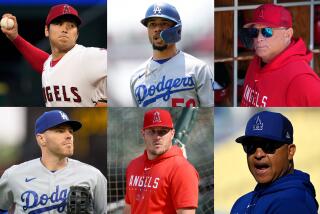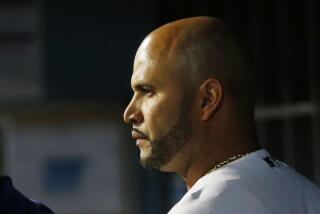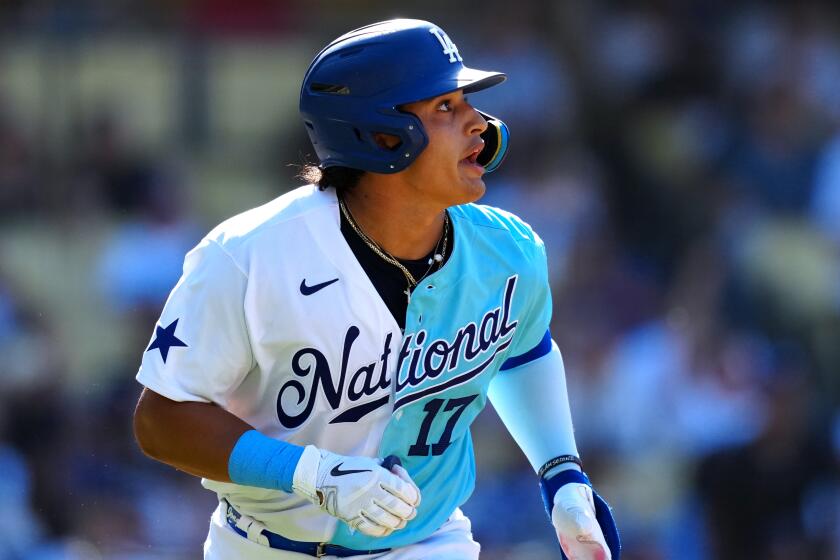Albert Pujols brings fear factor into play
TEMPE, Ariz. — Albert Pujols can be intimidating enough in the on-deck circle, from where the chiseled 6-foot-3, 230-pound slugger, standing erect with a bat on his shoulder, stares menacingly at pitchers, sizing them up like a lion stalking prey.
But in the batter’s box, with the ball about to be delivered, it’s an almost unnoticeable gesture, one akin to a rattlesnake coiling to strike, that can most unnerve a pitcher.
“The dude sticks his tongue out and bites it like he wants to hurt you,” said Angels right fielder Torii Hunter, who has hit behind Pujols all spring. “You can almost hear the pitcher saying, ‘Oh my God, he wants to eat my kids!’”
This is part of the presence Pujols brings, a force that can be generated only by a hitter as formidable as the new Angels first baseman, who signed a 10-year, $240-million deal in December and will make his first home appearance as an Angel on Monday night in the Freeway Series opener against the Dodgers.
A three-time National League most valuable player and two-time World Series champion, Pujols, 32, already has a Hall of Fame-worthy resume, hitting .328 with a .420 on-base percentage, 445 home runs and 1,329 runs batted in over 11 years with the St. Louis Cardinals.
He brings a fear factor the Angels haven’t had since Vladimir Guerrero in his 2004 MVP prime, one that could dramatically alter how pitchers approach the Angels and help transform their offense from second-rate to World Series-caliber.
“There’s a handful of hitters who you’re going to be intimidated by when they come to the plate; you’re going to feel them,” Angels ace Jered Weaver said. “And he’s definitely one of those guys.”
Dan Haren spent three seasons at Arizona before being traded to the Angels in 2010 and held Pujols to a .267 average (four for 15) in five starts against St. Louis. Pujols was a focal point, but Haren was as consumed by the first two batters.
“You wanted Albert to come up with no one on so you could go after him — that way, worst-case scenario, you give up a solo homer,” Haren said. “You cannot walk the guy ahead of him. The last thing you wanted was Albert coming up with two on and no outs. Then, you’re in big trouble.”
Former Angels shortstop David Eckstein led off for most of three seasons (2005-2007) in St. Louis, and he has a good idea why his three-year Cardinals average of .297 was higher than his .280 career mark.
“I probably saw more fastballs than anyone in the league,” Eckstein said. “I’m sure in their meetings they’re saying, ‘You can’t walk the first two guys.’ It makes the pitcher not nibble as much with you. Albert changes the whole dynamic.”
Former San Francisco infielder Rich Aurilia is another example of a player benefiting from the hitter behind him. Aurilia batted seventh or eighth for most of his career but moved to second in 2001 ahead of Barry Bonds, who hit a record 73 homers that season.
Aurilia batted .324 with 37 homers, 97 RBIs and an NL-leading 206 hits, well above his career single-season averages of .275, 18 homers, 74 RBIs and 155 hits.
“The guy could hit a fastball,” Colorado Manager Jim Tracy, the Dodgers manager in 2001, said of Aurilia. “How aggressive are you going to be with the guy in front of [Pujols] knowing that if you lose him, you have to deal with Albert with runners on base? I’ve seen enough of that to tell you that’s the case.”
Aurilia, who retired after 2009, said his monster 2001 wasn’t necessarily a byproduct of more fastballs.
“The difference is I got more strikes because they didn’t want someone on first with Barry up — they didn’t want to nibble and give me a free pass,” Aurilia said. “I got more mistakes. Sometimes pitchers try to bear down too hard to make a good pitch, and they make a mistake. More than half of my homers were on hanging breaking balls.”
Though Pujols’ career high in walks — 115 in 2009 — isn’t half as high as Bonds’ 232 walks in 2004, Pujols led the NL in intentional walks five of six times from 2005-2010. Tracy, who managed the Dodgers, Pittsburgh Pirates and Rockies in 10 of Pujols’ 11 Cardinals seasons, likened Pujols’ impact to that of Bonds.
“The question was, ‘Is Bonds six hitters away in any given inning?’ If he is, you run the possibility of the bases being loaded with two outs, and he gets to hit,” Tracy said. “You’re putting yourself in harm’s way if you allow people in front of Albert to constantly get on base.”
No wonder second baseman Howie Kendrick’s eyes light up when asked what it will be like hitting in front of Pujols this season. “Hopefully, a lot of fastballs,” he said. “It should be fun.”
Kendrick hit .285 with a career-high 18 homers and 63 RBIs last season, and if this spring is any indication — Kendrick is batting .396 with four homers and 15 RBIs in 19 exhibition games — he could be poised for a bigger 2012.
Kendrick punishes fastballs and hanging breaking balls, but soft stuff away has given him trouble. Though he doesn’t expect to be force-fed fastballs, he predicts pitchers will “attack me differently” with Pujols behind him, and that could result in more hittable pitches.
“The guy in front of Albert should have a better season,” said Angels reliever LaTroy Hawkins, who pitched in Milwaukee last season. “Look at [Ryan] Braun and Prince [Fielder]. Ryan was a huge success [for the Brewers] last year, and I think a lot of that had to do with Prince hitting behind him.”
If opponents pitch around Pujols, the cleanup batter — Hunter or Kendrys Morales — will have more RBI opportunities and the challenge of not being too eager.
“You have to be careful because when they walk Albert to get to you, you can’t think you have to do something Albert would do, like hit a home run,” Hunter said. “If you do, you’ll probably pop it up. I won’t get out of my game.”
Pujols said he doesn’t think about lineup groupings, keeping his focus on his game plan and a swing that is among the most explosive in the game — compact, precise, consistent in its path to the ball.
“I don’t look at who’s in front of me or behind me — that’s something I’ve learned,” Pujols said. “I focus on what I can do — looking for a pitch and driving it. I take care of my business. Those guys will do their job, which is getting on base, and hopefully I’ll do my job, which is driving them in.”
The Angels expect to have a deep and powerful lineup with Kendrick, Hunter, Morales, Mark Trumbo and Vernon Wells surrounding Pujols and the speedy Erick Aybar and Peter Bourjos setting the table.
But if opponents pitch around Pujols, the stress of feeling as though they have to retire everyone else could result in more mistake pitches.
“The pitchers are human, they’re going to relax somewhere else, so it should make the other guys better,” former Angels outfielder Tim Salmon said. “When other guys do damage, the pitchers are worn out when they have to face the middle of the order. It can be a snowball effect.”
One the Angels, who ranked 10th in the league in scoring and were shut out a major league-high 50 times through five innings last season, hope will result in a flurry of runs.
twitter.com/MikeDiGiovanna
More to Read
Go beyond the scoreboard
Get the latest on L.A.'s teams in the daily Sports Report newsletter.
You may occasionally receive promotional content from the Los Angeles Times.











